Cellular and 3D optical coherence tomography assessment during the initiation and progression of retinal degeneration in the Ccl2/Cx3cr1-deficient mouse
- PMID: 21854772
- PMCID: PMC3221782
- DOI: 10.1016/j.exer.2011.07.017
Cellular and 3D optical coherence tomography assessment during the initiation and progression of retinal degeneration in the Ccl2/Cx3cr1-deficient mouse
Abstract
Retinal pathologies common to human eye diseases, including abnormal retinal pigment epithelial (RPE) cells, drusen-like accumulation, photoreceptor atrophy, and choroidal neovascularization, have been reported in the Ccl2/Cx3cr1-deficient mouse. The Ccl2 gene encodes the pro-inflammatory chemokine CCL2 (MCP-1), which is responsible for chemotactic recruitment of monocyte-derived macrophages to sites of inflammation. The Cx3cr1 gene encodes the fractalkine receptor, CX3CR1, and is required for accumulation of monocytes and microglia recruited via CCL2. Chemokine-mediated inflammation is implicated in retinal degenerative diseases such as diabetic retinopathy, age-related macular degeneration, retinitis pigmentosa, and uveoretinitis, and proper chemokine signaling from the RPE, Müller glia, and astrocytes is necessary to regulate leukocyte trafficking. Therefore, this mouse, possessing aberrant chemokine signaling coupled with retinal degenerative pathologies, presents an ideal opportunity to investigate the effect of altered signaling on retinal homeostasis and photoreceptor degeneration. Since this mouse is a recent development, more data covering the onset, location, and progression rate of pathologies is needed. In the present study we establish these parameters and show two photoreceptor cell death processes. Our observations of decreased glutamine synthetase and increased glial fibrillary acidic protein suggest that Müller cells respond very early within regions where lesions are forming. Finally, we suggest that retinal angiomatous proliferation contributes to pathological angiogenesis in this Ccl2/Cx3cr1-deficient mouse.
Copyright © 2011 Elsevier Ltd. All rights reserved.
Figures
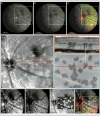

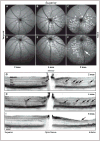
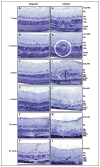

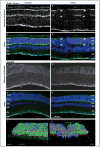
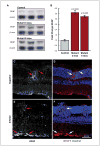
Similar articles
-
Ccl2, Cx3cr1 and Ccl2/Cx3cr1 chemokine deficiencies are not sufficient to cause age-related retinal degeneration.Exp Eye Res. 2013 Feb;107:80-7. doi: 10.1016/j.exer.2012.11.015. Epub 2012 Dec 8. Exp Eye Res. 2013. PMID: 23232206 Free PMC article.
-
Transcriptomics analysis of Ccl2/Cx3cr1/Crb1rd8 deficient mice provides new insights into the pathophysiology of progressive retinal degeneration.Exp Eye Res. 2021 Feb;203:108424. doi: 10.1016/j.exer.2020.108424. Epub 2020 Dec 26. Exp Eye Res. 2021. PMID: 33373623
-
Murine ccl2/cx3cr1 deficiency results in retinal lesions mimicking human age-related macular degeneration.Invest Ophthalmol Vis Sci. 2007 Aug;48(8):3827-36. doi: 10.1167/iovs.07-0051. Invest Ophthalmol Vis Sci. 2007. PMID: 17652758 Free PMC article.
-
Retinal ultrastructure of murine models of dry age-related macular degeneration (AMD).Prog Retin Eye Res. 2010 May;29(3):169-90. doi: 10.1016/j.preteyeres.2010.02.002. Epub 2010 Mar 3. Prog Retin Eye Res. 2010. PMID: 20206286 Free PMC article. Review.
-
CCL2/CCR2 and CX3CL1/CX3CR1 chemokine axes and their possible involvement in age-related macular degeneration.J Neuroinflammation. 2010 Dec 2;7:87. doi: 10.1186/1742-2094-7-87. J Neuroinflammation. 2010. PMID: 21126357 Free PMC article. Review.
Cited by
-
Adiponectin receptor 1 conserves docosahexaenoic acid and promotes photoreceptor cell survival.Nat Commun. 2015 Mar 4;6:6228. doi: 10.1038/ncomms7228. Nat Commun. 2015. PMID: 25736573 Free PMC article.
-
Chronic photo-oxidative stress and subsequent MCP-1 activation as causative factors for age-related macular degeneration.J Cell Sci. 2012 May 15;125(Pt 10):2407-15. doi: 10.1242/jcs.097683. Epub 2012 Feb 22. J Cell Sci. 2012. PMID: 22357958 Free PMC article.
-
Prospective study of common variants in CX3CR1 and risk of macular degeneration: pooled analysis from 5 long-term studies.JAMA Ophthalmol. 2014 Jan;132(1):84-95. doi: 10.1001/jamaophthalmol.2013.5506. JAMA Ophthalmol. 2014. PMID: 24287500 Free PMC article. Clinical Trial.
-
Fatty acid transport protein 4 (FATP4) prevents light-induced degeneration of cone and rod photoreceptors by inhibiting RPE65 isomerase.J Neurosci. 2013 Feb 13;33(7):3178-89. doi: 10.1523/JNEUROSCI.2428-12.2013. J Neurosci. 2013. PMID: 23407971 Free PMC article.
-
Hypothalamic CCL2/CCR2 Chemokine System: Role in Sexually Dimorphic Effects of Maternal Ethanol Exposure on Melanin-Concentrating Hormone and Behavior in Adolescent Offspring.J Neurosci. 2018 Oct 17;38(42):9072-9090. doi: 10.1523/JNEUROSCI.0637-18.2018. Epub 2018 Sep 10. J Neurosci. 2018. PMID: 30201767 Free PMC article.
References
-
- Bai Y, Ma JX, Guo J, Wang J, Zhu M, Chen Y, Le YZ. Müller cell-derived VEGF is a significant contributor to retinal neovascularization. J Pathol. 2009;219:446–454. - PubMed
-
- Campbell M, Humphries M, Kennan A, Kenna P, Humphries P, Brankin B. Aberrant retinal tight junction and adherens junction protein expression in an animal model of autosomal recessive Retinitis pigmentosa: The Rho(−/−) mouse. Exp Eye Res. 2006;83:484–492. - PubMed
-
- Cardona AE, Pioro EP, Sasse ME, Kostenko V, Cardona SM, Dijkstra IM, Huang D, Kidd G, Dombrowski S, Dutta R, Lee JC, Cook DN, Jung S, Lira SA, Littman DR, Ransohoff RM. Control of microglial neurotoxicity by the fractalkine receptor. Nat Neurosci. 2006;9:917–924. - PubMed
-
- Carter DA, Dick AD. CD200 maintains microglial potential to migrate in adult human retinal explant model. Curr Eye Res. 2004;28:427–436. - PubMed
Publication types
MeSH terms
Substances
Grants and funding
LinkOut - more resources
Full Text Sources
Other Literature Sources
Molecular Biology Databases
Research Materials
Miscellaneous

